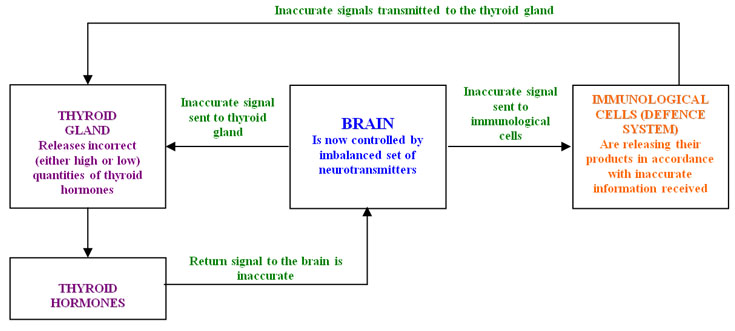The Thyroid
OVERVIEW EXPLANATION
The thyroid gland is one of the principal glands in the body and is dependent upon the controlled release of correct quantities of thyroid hormones to ensure that the entire body functions in a balanced state. In common with most bodily systems it is very complex and to assist the lay-person to appreciate its inter-dependency it is recommended that you view the diagnostic layouts which are shown below.
NORMAL SITUATION

IMBALANCED SITUATION

DETAILED EXPLANATION
To obtain a diagnosis that a patient is experiencing problems associated with The Thyroid is relatively simple, cheap and accurate. However an effective treatment strategy to rectify any faults discovered remains questionable according to the experience of many such patients.
The thyroid gland is one of the principle glands in the body. It contains specialised cells where The Thyroid hormones are produced and from which the hormones are released. Almost all the cells in the body have receptors to The Thyroid hormones, thyroxin (T4) and tri-iodothyronine (T3). When The Thyroid hormones bind to their receptors the chemical reactions (Metabolism) within a cell will increase. When The Thyroid hormone calcitonin binds to its receptor in the bone cells this will increase calcium deposition in the bone.
Thyroid stimulating hormone (TSH) causes The Thyroid gland to secrete thyroid hormones and it is produced in the anterior part of the pituitary gland. The release of thyroid-stimulating hormone from the anterior part of the pituitary is caused by Thyrotropin-releasing hormone (TRH). TRH itself is produced and released from the hypothalamus, which is part of the brain. Its release is controlled directly and indirectly, by neurochemicals in the brain, called neurotransmitters. It is well known that neurotransmitters such as noradrenaline, dopamine, serotonin, gaba-aminobutyric acid and acetylcholine will send signals directly, or through some Neuropeptides, to inhibit or to stimulate the release of TRH from the hypothalamus.
Additionally these neurotransmitters are responsible for the Inflammation/anti-Inflammation balance. When Inflammation becomes dominant, it can trigger, throughout its agents called tumour necrosis factor alpha and interferon gamma, the suppression of the release of The Thyroid hormones from The Thyroid gland, even if there are signals from TRH and TSH to release these hormones. Therefore the brain chemistry is primarily responsible for the normal thyroid functioning.
Whilst the initial diagnosis has revealed the symptoms correctly it has failed to reveal the precise cause and, irrespective of the illness involved, an effective treatment can only be introduced when the precise cause is identified. It should be noted that every single person has his, or her, own unique imbalances due to the influence of individual factors including the influence of genes. Therefore our package of assays have been selected so that they identify where, precisely, the problems lie so that a unique treatment strategy can be prepared for each individual patient.
APPLICATION
This assay will provide extremely valuable and accurate information relating to all pathological conditions.
The thyroid gland is one of the principal glands in the body and is dependent upon the controlled release of correct quantities of thyroid hormones to ensure that the entire body functions in a balanced state. In common with most bodily systems it is very complex and to assist the lay-person to appreciate its inter-dependency it is recommended that you view the diagnostic layouts which are shown below.
NORMAL SITUATION

IMBALANCED SITUATION

DETAILED EXPLANATION
To obtain a diagnosis that a patient is experiencing problems associated with The Thyroid is relatively simple, cheap and accurate. However an effective treatment strategy to rectify any faults discovered remains questionable according to the experience of many such patients.
The thyroid gland is one of the principle glands in the body. It contains specialised cells where The Thyroid hormones are produced and from which the hormones are released. Almost all the cells in the body have receptors to The Thyroid hormones, thyroxin (T4) and tri-iodothyronine (T3). When The Thyroid hormones bind to their receptors the chemical reactions (Metabolism) within a cell will increase. When The Thyroid hormone calcitonin binds to its receptor in the bone cells this will increase calcium deposition in the bone.
Thyroid stimulating hormone (TSH) causes The Thyroid gland to secrete thyroid hormones and it is produced in the anterior part of the pituitary gland. The release of thyroid-stimulating hormone from the anterior part of the pituitary is caused by Thyrotropin-releasing hormone (TRH). TRH itself is produced and released from the hypothalamus, which is part of the brain. Its release is controlled directly and indirectly, by neurochemicals in the brain, called neurotransmitters. It is well known that neurotransmitters such as noradrenaline, dopamine, serotonin, gaba-aminobutyric acid and acetylcholine will send signals directly, or through some Neuropeptides, to inhibit or to stimulate the release of TRH from the hypothalamus.
Additionally these neurotransmitters are responsible for the Inflammation/anti-Inflammation balance. When Inflammation becomes dominant, it can trigger, throughout its agents called tumour necrosis factor alpha and interferon gamma, the suppression of the release of The Thyroid hormones from The Thyroid gland, even if there are signals from TRH and TSH to release these hormones. Therefore the brain chemistry is primarily responsible for the normal thyroid functioning.
Whilst the initial diagnosis has revealed the symptoms correctly it has failed to reveal the precise cause and, irrespective of the illness involved, an effective treatment can only be introduced when the precise cause is identified. It should be noted that every single person has his, or her, own unique imbalances due to the influence of individual factors including the influence of genes. Therefore our package of assays have been selected so that they identify where, precisely, the problems lie so that a unique treatment strategy can be prepared for each individual patient.
APPLICATION
This assay will provide extremely valuable and accurate information relating to all pathological conditions.

